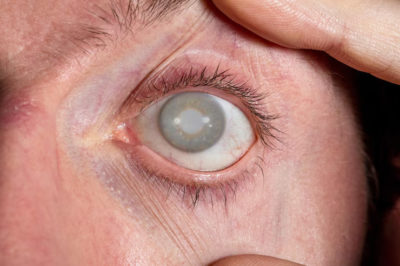Cataract surgery is one of the most common and successful surgical procedures performed worldwide. It offers renewed clarity and brightness to those who may have suffered from clouded vision for years. However, some people report experiencing a curious side effect after the procedure: a persistent blue tint or “blue vision.” If you’ve recently had cataract surgery and find yourself seeing a blue haze or color distortion, you’re not alone, and there are explanations for this experience.
In this blog, we’ll explore the reasons behind the phenomenon of a blue tint after cataract surgery, what it means, why it happens, and how long it typically lasts. We’ll also cover ways to cope with this unusual color distortion and when it might be time to consult your eye doctor.
Why Does Color Distortion Happen After Cataract Surgery?
To understand why some people experience color distortion after cataract surgery, it helps to know a bit about how cataracts develop and how they affect vision. Cataracts are caused by a buildup of proteins in the eye’s natural lens, which gradually clouds vision. For people with advanced cataracts, this clouding process causes colors to appear dull and muted, often giving everything a yellow or brown tint.
When a cataract is removed during surgery, the cloudy natural lens is replaced with a clear artificial intraocular lens (IOL). This new lens provides sharp vision but may result in some temporary color distortions, including a blue tint or blue haze after cataract surgery. The primary reason for this color distortion is that the IOL allows more light, particularly blue light, to reach the retina. Without the filtering effect of a cloudy, yellowish natural lens, colors appear differently, especially cooler shades like blue.
What Causes the Blue Tint After Cataract Surgery?
The blue tint or haze that some people notice after cataract surgery can be attributed to several factors, mainly involving light filtration changes, adaptation of the brain, and the properties of the new IOL. Here are some of the primary reasons why you might be seeing a blue color after cataract surgery:
1. Absence of Yellow Tint from the Natural Lens
Before cataract surgery, the natural lens in the eye often becomes discolored with age, developing a yellow or brown tint. This tinted lens blocks some blue light, which can mute colors and distort the color spectrum. When this yellowish lens is removed, the eye suddenly receives more blue light, making objects appear with a cooler hue, especially in the initial weeks post-surgery.
2. Increased Sensitivity to Blue Light
The new artificial lens doesn’t filter blue light in the same way the natural lens did, allowing more of this spectrum to pass through. Increased sensitivity to blue light can manifest as a blue haze or blue tint in vision, particularly noticeable in low-light conditions.
3. Neuroadaptation Process
The brain needs time to adjust to the changes in light and color processing after cataract surgery. As it recalibrates to the new lens, you may experience a temporary phase where colors appear distorted. Neuroadaptation is a normal part of post-surgery recovery, and most people find that the blue tint gradually fades as their brain adapts to the new lens over time.
4. Light Sensitivity Following Surgery
Cataract surgery makes the eye more sensitive to light in general. This can exacerbate the perception of the blue hue, especially under certain lighting conditions. Bright or fluorescent lights may intensify this effect, leading to a more prominent blue color distortion.
How Long Does the Blue Haze Last?
Most patients find that the blue haze after cataract surgery is temporary. For many, this effect diminishes within days or weeks as the brain and eyes adjust to the new lens. However, in some cases, the adjustment period may last a few months.
If the blue tint persists beyond a few months or if it is causing significant discomfort or difficulty with daily activities, it may be beneficial to consult your eye doctor. In some cases, adjusting the lighting in your home or wearing tinted glasses may alleviate the discomfort associated with blue light sensitivity.
Coping with Blue Vision After Cataract Surgery
If the blue tint after cataract surgery is distracting or uncomfortable, here are a few strategies that may help you adapt:
1. Wear Tinted Sunglasses
Sunglasses with a slight tint, particularly those designed to filter blue light, can reduce the effect of the blue haze, especially in bright environments or while outdoors. They can also be helpful in indoor settings with fluorescent lighting, which often intensifies the appearance of blue hues.
2. Adjust Indoor Lighting
Warm lighting (such as yellow or soft white bulbs) can help balance the blue tones and make your surroundings appear more natural. Try to avoid bright white or “daylight” bulbs in your home, as these tend to emit more blue light.
3. Be Patient with Your Vision
The adaptation process is unique to each person, and patience is key. As your brain adjusts to the absence of the yellow-tinted lens, the blue tint should become less noticeable. Over time, your brain’s neuroadaptation should reduce the color distortion after cataract surgery, making colors appear more normal.
4. Consider Blue Light Blocking Glasses for Screen Time
If you find that the blue tint is particularly strong when using digital devices, blue light-blocking glasses can help reduce eye strain and minimize blue light exposure. These glasses are readily available and may be especially useful if you spend significant time in front of a computer or smartphone.
Is the Blue Tint Normal, or Should You Be Concerned?
In most cases, seeing a blue tint after cataract surgery is a normal and harmless side effect. It’s part of the eye and brain’s adjustment process to the new IOL, which lacks the filtering properties of the natural lens. However, it’s essential to keep an open line of communication with your eye care provider, especially if the blue haze lasts for an extended period or is accompanied by other symptoms such as:
- Persistent blurred vision
- Eye pain or discomfort
- Flashes of light or floaters
- Any other unusual changes in vision
While rare, these could indicate potential complications that need attention. Cataract surgery has a high success rate, and significant issues are uncommon, but it’s always best to err on the side of caution.
Long-Term Vision Benefits Outweigh Temporary Color Distortion
While the blue haze or blue color after cataract surgery can be unsettling, it is generally a short-lived experience. For most people, the renewed clarity, sharpness, and brightness that cataract surgery provides far outweigh the temporary color distortion. Seeing colors as they truly are, without the yellowish cast from cataracts, can be an eye-opening experience in itself.
Patients often remark on how vivid the world appears post-surgery, describing it as if they’re seeing things “in HD” for the first time. Colors appear sharper and more vibrant, and the world around them feels more alive. Despite the initial blue vision, the end result is typically an improved quality of life and a more vibrant visual experience.
Seeing a blue tint or experiencing color distortion after cataract surgery is a relatively common phenomenon that many patients encounter. This blue haze is typically a temporary side effect resulting from the replacement of the eye’s natural lens with a clear IOL. As the brain adjusts, this effect tends to diminish, and colors should appear more natural.
If you’re experiencing blue vision after cataract surgery, know that it’s usually a normal part of the recovery process. Tinted glasses, warm lighting, and patience can make this period more comfortable, and in time, the blue haze should fade. However, if the blue tint persists or you have concerns, don’t hesitate to contact your eye doctor.
Cataract surgery opens up a clearer, brighter world, and any temporary color distortion is typically a small and manageable step on the journey to improved vision.









